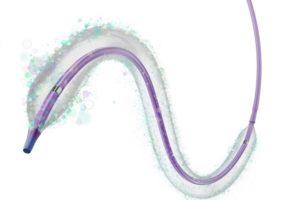
The IN.PACT Admiral drug-coated balloon (DCB; Medtronic) exhibits a consistent and durable treatment effect in “a more complex patient demographic than typically seen in other DCB pivotal trials”, Osamu Iida (Kansai Rosai Hospital, Hyogo, Japan) informed the audience at the Leipzig Interventional Course (22–25 January, Leipzig, Germany). These are the first reported outcomes from an independently-adjudicated, randomised, single-blind trial evaluating DCB use in Japanese patients through to three years, providing level I evidence in favour of the device’s use.
The study investigators set out to assess the safety and efficacy of the IN.PACT Admiral DCB for the interventional treatment of de novo and non-stented restenotic lesions in the superficial femoral artery and the proximal popliteal artery as compared to treatment with standard percutaneous transluminal angioplasty (PTA).
The trial met both its primary effectiveness and primary safety end-points at one year, and continued to demonstrate safety and efficacy at three years. The primary effectiveness end-point was primary patency at 12 months, defined as freedom from clinically-driven target lesion revascularisation (TLR) and freedom from restenosis as determined by duplex ultrasound-derived peak systolic velocity ratio (PSVR) less than or equal to 2.4.
Three-year primary patency by Kaplan-Meier estimate was significantly better in the DCB arm than the PTA arm: 68.9% compared to 46.9%. At one year, this difference was even more marked, with a primary patency in the DCB arm of 93.9%, compared to a primary patency of 46.9% in the PTA arm at the same time point.
The time to clinically-driven target lesion revascularisation was also significantly greater in the DCB arm, nearly four times longer in fact, at an average of 613.2±243.1 days (range: 235–910 days), compared to just 168.2±65.4 days (range: 57–247 days) amongst the PTA cohort (p<0.001). In addition, although not statistically significant, the three-year freedom from clinically driven TLR was slightly better in the DCB arm, at 84.4% versus 81.3% in the PTA group.
The primary safety endpoint was freedom from device- and procedure-related death through 30 days, and freedom from target limb major amputation and clinically-driven target vessel revascularisation within 12 months’ post-index procedure.
Iida told the LINC audience: “The 36-month major adverse event rate was very low in the DCB arm, just 20.9% [14 out of 67 patients], compared to 31% [9 out of 29 patients] in the PTA arm.” The primary safety composite score was 83.6% for the DCB cohort, and 75.9% for the PTA cohort. All-cause death was low in both groups: 6% (four out of 67 patients) in the IN.PACT Admiral group, and 6.9% (two out of 29 patients) in the angioplasty group.
Iida also emphasised that these results in the IN.PACT Japan trial are consistent with those of the previous IN.PACT Global and IN.PACT SFA studies. The primary patency through to three years in the IN.PACT Admiral cohort of the Japan trial closely matches the 69.5% primary patency observed in the DCB arm of the IN.PACT SFA trial. Clinically-driven target lesion revascularisation was 14.9% in the Japanese trial, compared with 15.2% in the IN.PACT SFA trial and 23.5% amongst the global clinical cohort.
A complex patient cohort
Iida described the patient cohort used in this trial as “a more complex patient demographic than typically seen in other DCB pivotal trials.” The average age in the DCB arm was 73.3±7.4, and the incidence of diabetes mellitus was high: 58.7% in the treatment group (40 out of 68 patients). In the PTA arm, the baseline characteristics were not statistically significantly different, with an average age of 74.2±6.1, and with 56.3% of the 32 patients being diabetic.
“This population is older, and has a higher proportion of diabetic patients, than is typically seen in other DCB clinical trials,” Iida said.
Lesion characteristics were also the same between the two arms of the study. The mean lesion length was 9.15±5.85cm in the 68 patients treated with the DCB, and 8.89±6.01cm in the 32 patients treated with angioplasty—“one of the longest [average lesion lengths] in any DCB trial”, according to Iida. The difference in mean lesion length between the DCB and PTA arms was not statistically significant (p=0.838).
Unique to this trial, the study investigators used intravascular ultrasound (IVUS) to evaluate the ideal diameter for balloon selection. Iida explained that “IVUS is generally used by the Japanese physician as a part of daily practice.”
He added, “We observed a very low provisional stenting rate of 4.4% in the DCB arm, versus 3.1% in the PTA arm.”












